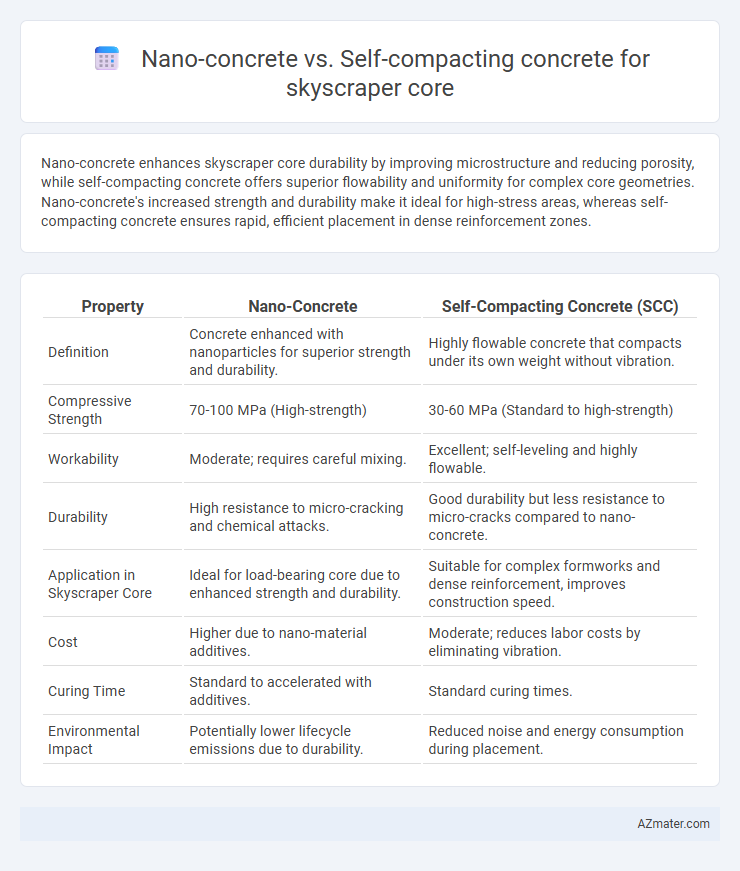Nano-concrete enhances skyscraper core durability by improving microstructure and reducing porosity, while self-compacting concrete offers superior flowability and uniformity for complex core geometries. Nano-concrete's increased strength and durability make it ideal for high-stress areas, whereas self-compacting concrete ensures rapid, efficient placement in dense reinforcement zones.
Table of Comparison
| Property | Nano-Concrete | Self-Compacting Concrete (SCC) |
|---|---|---|
| Definition | Concrete enhanced with nanoparticles for superior strength and durability. | Highly flowable concrete that compacts under its own weight without vibration. |
| Compressive Strength | 70-100 MPa (High-strength) | 30-60 MPa (Standard to high-strength) |
| Workability | Moderate; requires careful mixing. | Excellent; self-leveling and highly flowable. |
| Durability | High resistance to micro-cracking and chemical attacks. | Good durability but less resistance to micro-cracks compared to nano-concrete. |
| Application in Skyscraper Core | Ideal for load-bearing core due to enhanced strength and durability. | Suitable for complex formworks and dense reinforcement, improves construction speed. |
| Cost | Higher due to nano-material additives. | Moderate; reduces labor costs by eliminating vibration. |
| Curing Time | Standard to accelerated with additives. | Standard curing times. |
| Environmental Impact | Potentially lower lifecycle emissions due to durability. | Reduced noise and energy consumption during placement. |
Introduction to Nano-Concrete and Self-Compacting Concrete
Nano-concrete incorporates nanoparticles such as silica fume and carbon nanotubes to enhance mechanical properties like strength, durability, and resistance to microcracking, making it highly suitable for the demanding load conditions of skyscraper cores. Self-compacting concrete (SCC) achieves high fluidity through a carefully designed mix of superplasticizers and fine aggregates, enabling effortless flow and consolidation without vibration, which improves construction speed and structural uniformity in tall building cores. Both materials optimize core performance, but nano-concrete excels in enhancing nano-scale material characteristics while SCC focuses on improved workability and homogeneity.
Material Composition and Technology Comparison
Nano-concrete incorporates nanoparticles such as nanosilica and carbon nanotubes to enhance strength and durability, improving the microstructure and reducing permeability. Self-compacting concrete (SCC) features a high flowability mixture with superplasticizers and viscosity-modifying agents, enabling it to fill complex formwork without mechanical vibration. While nano-concrete offers superior mechanical properties through nanotechnology integration, SCC excels in workability and uniformity, crucial for the dense reinforcement in skyscraper cores.
Strength and Durability in Skyscraper Cores
Nano-concrete demonstrates enhanced strength due to the incorporation of nanoparticles that fill micro-pores, leading to a denser and more resilient core structure in skyscrapers. Self-compacting concrete (SCC) offers superior workability and uniformity, reducing the risk of voids and segregation, which contributes to consistent durability in high-rise building cores. The combination of nano-concrete's improved microstructure and SCC's flowability optimizes both strength and longevity in skyscraper core construction.
Workability and Placement Efficiency
Nano-concrete enhances workability and placement efficiency in skyscraper cores through improved particle packing and reduced water demand, resulting in a more cohesive mix with superior flow properties. Self-compacting concrete (SCC) offers excellent workability due to its highly flowable nature, enabling it to fill complex formworks without mechanical vibration, thus accelerating placement. While both materials promote efficient placement, nano-concrete provides enhanced strength and durability, making it particularly advantageous for high-performance core structures.
Structural Performance Under High Loads
Nano-concrete exhibits superior structural performance under high loads for skyscraper cores due to its enhanced microstructure, which significantly improves compressive strength and durability compared to self-compacting concrete. The integration of nanoparticles like nano-silica refines the concrete matrix, reducing porosity and increasing resistance to cracking and deformation under extreme stress. Self-compacting concrete offers ease of placement and uniformity but generally falls short in load-bearing capacity and long-term resilience when subjected to the intense forces encountered in skyscraper core applications.
Environmental Impact and Sustainability
Nano-concrete enhances the environmental sustainability of skyscraper cores by reducing cement usage through improved strength and durability, which lowers carbon emissions associated with traditional concrete production. Self-compacting concrete (SCC) offers sustainable benefits by minimizing the need for mechanical vibration, reducing energy consumption and noise pollution on construction sites. Both materials contribute to eco-friendly skyscraper construction, with nano-concrete optimizing material efficiency and SCC enhancing worksite environmental management.
Cost Analysis: Initial Outlay and Lifecycle
Nano-concrete, enhanced with nanomaterials like nano-silica, often incurs higher initial costs due to advanced materials and specialized production processes, while self-compacting concrete (SCC) generally offers moderate initial expenses tied to its admixtures and mix design complexity. Over the lifecycle, nano-concrete can deliver superior durability, reduced maintenance, and enhanced structural performance, potentially lowering long-term costs compared to SCC, which may require more frequent repairs and maintenance under high-stress skyscraper core conditions. Cost-benefit analysis favors nano-concrete for skyscraper cores when considering total cost of ownership, despite its higher upfront investment.
Challenges in Mixing and On-Site Application
Nano-concrete presents challenges in mixing due to the need for precise nanoparticle dispersion, which requires specialized equipment and expertise to avoid agglomeration affecting structural integrity. Self-compacting concrete demands careful control of viscosity and segregation resistance to ensure uniform flow into complex core forms without mechanical vibration. Both materials require rigorous quality control on-site to maintain performance, with nano-concrete's sensitivity to mixing conditions and self-compacting concrete's dependency on admixture balance posing critical challenges in skyscraper core construction.
Case Studies: Real-World Skyscraper Projects
Case studies comparing nano-concrete and self-compacting concrete in skyscraper cores reveal significant performance distinctions. The Burj Khalifa employed self-compacting concrete to optimize high-flowability and reduce labor time for its core, demonstrating enhanced constructability in high-rise applications. In contrast, nano-concrete was utilized in select Asian tower projects, showing superior strength, durability, and improved microstructure, boosting load-bearing capacity and resistance to environmental stressors.
Future Trends in Concrete Innovation for High-Rises
Nano-concrete enhances skyscraper core performance by incorporating nanomaterials that improve strength, durability, and crack resistance at a microscopic level. Self-compacting concrete (SCC) offers superior flowability and uniformity, enabling faster construction and better quality in complex core structures without vibration. Future trends emphasize integrating nano-additives within SCC formulations to create hybrid concretes, maximizing structural efficiency and sustainability in high-rise developments.

Infographic: Nano-concrete vs Self-compacting concrete for Skyscraper core
 azmater.com
azmater.com